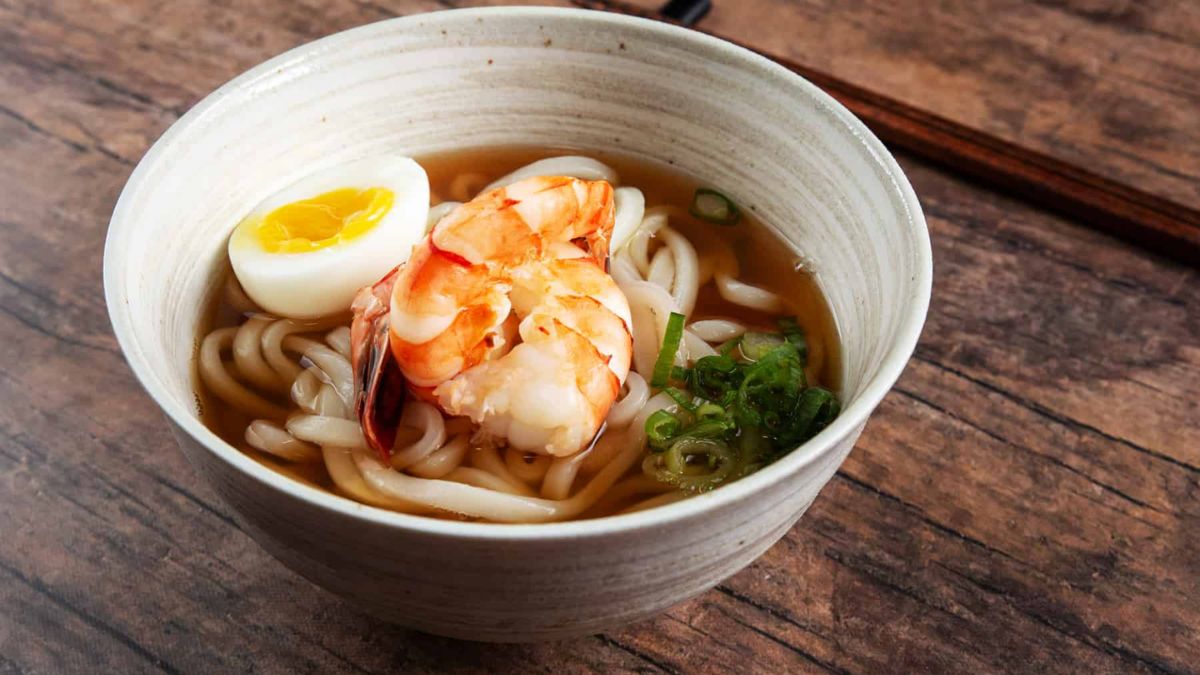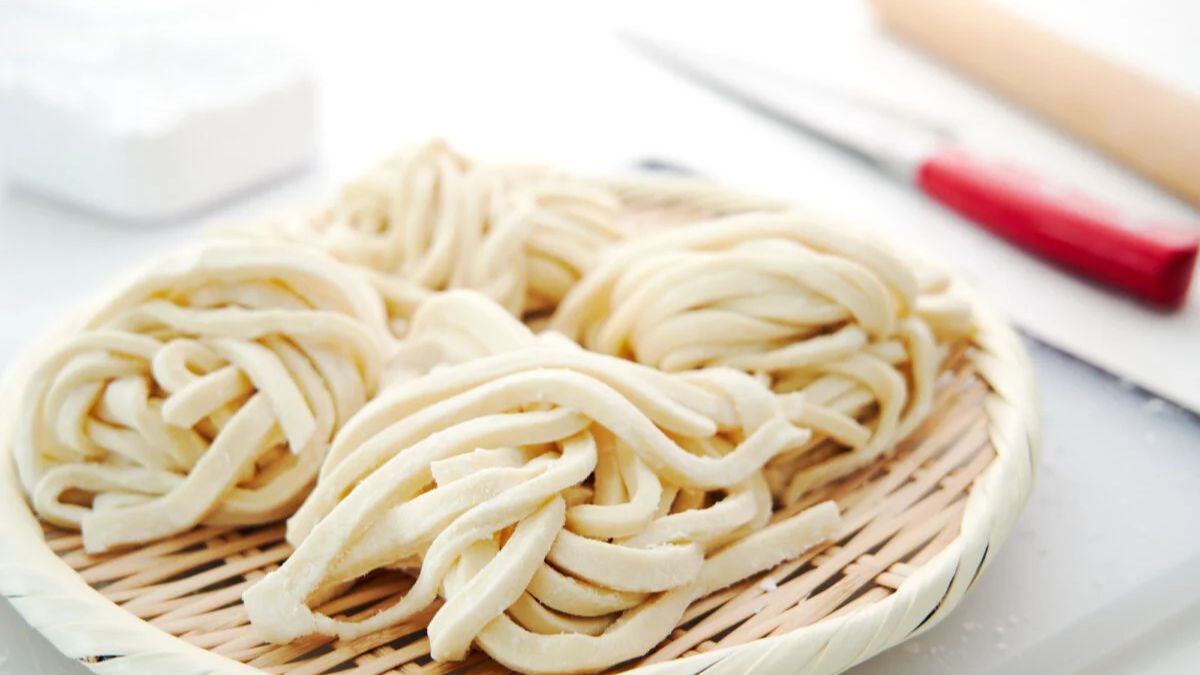Udon is a kind of thick Japanese noodle that is usually made with wheat flour. It is often served in soups with different broths and toppings or in a simple, clear broth with a sprinkle of spring onions. In the summer, udon can also be served cold with a dipping sauce, salad, or chilled broth.
Udon is chewy Japanese noodles made from wheat flour, water, and salt. They are usually served in a simple broth made from dashi. They are thicker than buckwheat soba noodles, usually two to four millimetres, and can be flat or round. Udon dough can be hard to work with, and some people swear by stomping on it to loosen it up.
What are Udon Noodles?
Udon is a thick Japanese strand noodle that can come in different sizes, shapes, and other ingredients. It is usually served in soup. Most udon noodles are made from wheat flour, but in some parts of the world, they are made with potato starch or carrots to make them orange. Udon is usually round or square and thick, but it can also be flat and ribbon-like. It can be bought fresh or dried, and when boiled before eating, it makes noodles that are both slippery and chewy.
Most udon comes from Japan and is sold dried or frozen. However, some markets sell udon that has already been cooked and can be warmed up in soup or stir-fried and served. Udon is sold in grocery stores, Asian markets, and online. It tends to be a little more expensive than regular pasta, and Asian markets have more things to choose from and sometimes sell fresh udon noodles. Instant soups that come in a package and use udon noodles are popular in Japan and other Asian countries.
Before serving, udon noodles are boiled in water and can be used right out of the package. They are often used in soups like Kake udon, just noodles, broth, or soups with curry or red miso broth that have more flavour. Popular toppings include tempura or fried tofu and shrimp, as well as eggs and different kinds of meat and vegetables. Udon can be stir-fried with sauce or served cold with a sauce to dip it in (zaru udon).
How to Make Homemade Udon Noodles?
You can make your udon noodles home with flour, salt, and water. Knead the dough for a few minutes until it is smooth, then let it rest for at least an hour. This will make it easier to roll out the dough. Use a floured rolling pin to roll the dough out on a floured counter, turning it 90 degrees every few rolls until it’s the thickness you want (usually just under 1/4 inch). Cut into noodles, dust with flour or cornstarch, and cook immediately in water simmering for 5 to 10 minutes, depending on how thick the noodles are. They will stay afloat.
Dry udon can be cooked by adding it directly to boiling water. Depending on the type, this can take anywhere from 8 to 12 minutes. Taste a noodle to see if it’s ready. It should be chewy, without a hard spot in the middle, and not too soft. Fresh, uncooked udon that has been frozen can usually be cooked without first being thawed. Follow the directions on the package for each kind of udon.
All boiled udon should be cooked in a lot of boiling water, so it doesn’t stick and turns out right. Udon noodles that have already been cooked and come in a package can often be added to hot broth or stir-fried right from the box. In the pot or pan, they will heat up and finish cooking.
The ingredients and method for making udon noodles are very simple!
Homemade Udon Noodle Recipe
- 1½ –2 cups of water
- Three tablespoons salt
- 8 cups all-purpose flour
- Cornstarch or potato starch, for dusting (optional: Use flour if you don’t have cornstarch or potato starch)
Instructions
- Stir water and salt together in a large bowl or measuring cup until the salt is dissolved.
- Pile the flour into a mound with a well in the middle on a clean work surface. Slowly pour water into the center of the well and mix it with your hands to make a stiff dough. (You might not use all of the water, or you might need a little more. Flour with more protein, like bread flour, will need more water.)
- Give the dough a 10-minute break. Knead the dough for about 5 minutes until it is firm but smooth. If you find it hard to knead the dough, you can put it in a heavy-duty resealable plastic bag and cut a hole in the top so air can escape. Put the bag of dough between two clean kitchen towels and knead it with your feet.
- Cover the dough with a clean, damp kitchen towel and let it rest for two to eight hours, depending on the kitchen’s temperature (more time in a cold room, less time in a hot room).
- Sprinkle flour on a clean work surface and use a rolling pin to roll the dough into a rectangle that is 14 to 18 of an inch thick, turning the dough as you go. (You can also roll out dough with a pasta machine.)
- Dust the dough with starch and fold it into quarters accordion-style, with the short end of the rectangle facing you. There should be enough space between the folds to fit a chopstick into the centrefold.
- Use a sharp kitchen knife to cut the rolled-out dough into noodles that are 14 inches thick. Lift the noodles by putting a chopstick through the centrefold and onto the noodles.
- Bring a big pot of water without salt to a boil. Slowly add the noodles so that the water stays at a spot. Cook the noodles until they are a little softer than al dente. Drain and rinse the noodles under cold running water, shaking the colander to keep the noodles apart. Serve in a soup or with a sauce to dip.
Notes
- Two sets of chopsticks were used. At first, it seemed a bit sticky.
- Just in case, I used two ziplock bags.
- If you do it more than 50 times, the udon will get too chewy.
- If you don’t have corn or potato starch and want to cook all the udon noodles at once, you can use all-purpose flour instead.
- When the dough is cooked, the water makes it grow, so it needs to be cut thinner.
- Unless you have a big pot, cook one serving at a time.
Some Top Udon Recipes
Some popular udon dishes are tempura udon, a soup with noodles and tempura (usual shrimp) on top, Hayashi yamakake udon, a chilled noodle dish with grated Japanese mountain yam, and kitsune udon, which is topped with fried, crispy tofu.
- Tempura Udon
- Hiyashi Yamakake Udon
- Kitsune Udon
Nutrition
Calories: 338kcal | Carbohydrates: 62g | Protein: 10g | Fat: 5g | Saturated Fat: 1g | Sodium: 1993mg | Potassium: 143mg | Fiber: 3g | Sugar: 1g | Calcium: 103mg | Iron: 5mg
Where did Udon Noodles Originate?
The first udon noodles probably came from China and were brought to Japan during the Tang dynasty (618–907 C.E. ). It’s possible that the first udon was more like a dumpling than a noodle, and in some parts of Japan, udon is still cut into squares instead of the long strands that became the norm in the 1300s.
Udon used to be made at home, but when commercial cooking became popular in the 1600s, it started to be sold in stalls. Udon is eaten all over Japan but is most popular in the south, from Osaka to Kyushu.
Udon vs. Soba Noodles
The most well-known noodles from Japan are udon and soba, and people love them both. Soba noodles are made with buckwheat flour, which gives them a slightly darker colour than udon noodles, usually white. Because it is made with buckwheat flour, soba tends to taste more nutty and earthy. Soba is also thinner and more like spaghetti than udon.
The two kinds of noodles are used in soups and cold dishes in similar ways. You can use either if you need to, but the experience will be slightly different.
How are Udon Noodles Typically Served?
Udon noodles are usually served in a hot broth as a soup, but they can also be served cold with a sauce to dip them in. Some of the most popular things to make with udon are:
1. Kake udon. Kakeru, a noodle broth made from dashi, soy sauce, and mirin, is the easiest way to serve udon.
2. Miso Mikomi udon. Hearty udon stew made with vegetables in miso soup.
3. Curry udon. They are coated in a roux of Japanese curry.
4. Udon suki. A hot pot noodle dish in which cooked udon noodles are served on a platter with bean curd, bamboo shoots, eel, shrimp, shiitake mushrooms, mochi, and daikon radish, spinach, and chicken on top. Individual bowls of broth are served on the side for dipping.
5. Yaki udon. Soy sauce, sesame oil, and vegetables like scallions, napa cabbage, or bok choy are stir-fried with udon. Sometimes sesame seeds are sprinkled on top. It can be made without meat or with it.
What are the Varieties of Udon Noodles?
Udon noodles are springy and slippery in a way that others are not, but Japanese soba noodles can often be used in their place. Soba holds up well in both hot and cold soups, and the texture won’t be quite the same, but it will still be good. When making an udon stir-fry, you can use thick Chinese egg noodles instead of udon.

